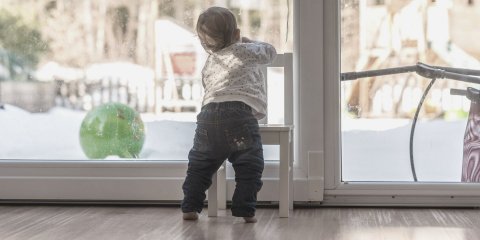Key Points
- Head injuries may be external (to the scalp) or internal (involving the brain, blood vessels or skull)
- Signs of a brain injury can include vomiting, dizziness and confusion, loss of consciousness and bleeding from the ears, among others
- The mildest form of traumatic brain injury is a concussion - this may or may not be accompanied by loss of consciousness
- If your toddler loses consciousness, even for a second, or has experienced a very hard knock, they require immediate medical attention
That first time your little one hits their head hard, it’s terrifying. It may have happened when they were just a baby, and learning to sit, crawl or walk.
And as toddlers, it seems even harder to keep them safe from such knocks and bumps. They are busy exploring their world after all - and usually at full pelt!
When you’re faced with situations where your toddler has hit their head, it can also help to know about the signs to look for and what to do.
Why are toddlers more prone to head injuries?
If it seems like your toddler falls and hits their head more often than any older child or adult you know, it’s for good reason.
After all, they do not have the level of head control that adults do. This is because their neck muscles are still developing as they grow, and their heads are also larger in relation to the size of their bodies (it’s part of what gives them that distinct toddler-look).

Their centre of gravity is also out, because their legs are shorter in proportion to their bodies when compared with adults. This places their centre of gravity closer to their heads.
Finally, they are so busy learning new skills , that they are simply more likely to take a tumble as they move about - whether running, jumping or climbing. Particularly if these are skills they are still trying to master.
Toddlers don’t just hit their heads as part of falls - although this has been found to be the leading cause of head injuries in toddlers.
Toddlers may also hit their heads as a result of a bike accident, car crash, sporting injury, or from child abuse.
Signs of a head injury
Head injuries may be external , primarily involving damage to the scalp. Or they can be “ internal and involve the skull, brain, or blood vessels .”
It’s important to note that research has determined most household falls do not result in a neurological injury. However, toddlers do appear to be “more vulnerable to neurological impairment compared with” infants. This vulnerability is due to their faster movements , and larger mass of their head and torso.
...for impact events, the toddler is likely less vulnerable to skull fracture but more vulnerable to neurological impairment compared with the infant ...Journal of Neurosurgery
But, how do you know if your toddler may have suffered a neurological injury?
Queensland Health’s website provides a comprehensive list of things to watch for . These include:
- “frequent vomiting
- severe or persistent headache or dizziness
- seizure like activity
- unusual or confused behaviour
- restlessness, drowsiness or irritability in a baby
- inability to wake up
- weakness of the arms or legs
- poor coordination
- slurred speech
- double or blurred vision
- bleeding from the ears”
These signs may not necessarily develop immediately, as bleeding or swelling of the brain can occur later. That’s why your toddler should continue to be monitored for these signs of a brain injury in the days following a hard knock.
The mildest form of a traumatic head injury is called a concussion . You may already have an idea of what you think a concussion is, but you should know that there actually isn’t a universally accepted definition of concussion.
But, it is universally accepted that a concussion results in :
- Rapid impairment in brain function that is temporary and gets better by itself
- A variety of symptoms, but not necessarily loss of consciousness
What to do when your toddler hits their head
To begin with, always remain calm when your toddler hits their head. This helps to calm them as much as possible and allows you to think clearly about your best course of action.
If your toddler develops any of the signs and symptoms listed above , they require immediate medical attention . If they are not showing these signs, but your toddler has experienced a significant impact , such as falling from a height or being in a car accident, they should also receive immediate medical attention .
If your child is unconscious, please call 000 immediately to request an ambulance.
Can a toddler sleep after hitting their head?
You might be wondering whether or not you should let your toddler sleep after hitting their head. If they are showing signs of a head injury, then you should follow your medical provider’s instructions regarding sleep.

If your toddler seemed quite well after hitting their head, Queensland Health’s website has set out some clear instructions to follow:
If they seem well, you may let them sleep, but must rouse them every hour for the first 4 hours . If they respond normally, you may continue to let them sleep. But, if they seem dazed, seek immediate medical attention.
After the first 4 hours of sleep, wake them every 2 hours to check their condition. You should continue to do this for 24 hours after the impact.
An excellent number to have on hand (in Australia) if you would like advice for your toddler’s specific situation is 13 HEALTH (13 43 25 84). When you call this number you can speak to a registered nurse. Please note that if it is an emergency, you should call 000, not 13 HEALTH.
How to prevent head injuries
Try as we might, we can’t protect our toddlers from every injury. But there are certainly steps we can take to reduce the risk of head injuries occurring. These include:
- Making your home as safe as possible
- Using helmets when riding bikes and trikes etc.
- Using car seats which are installed correctly
- Using appropriate restraint systems, whether in cars, child bike seats, prams and high chairs
If your toddler hits their head and you are concerned for any reason, always seek medical attention.

